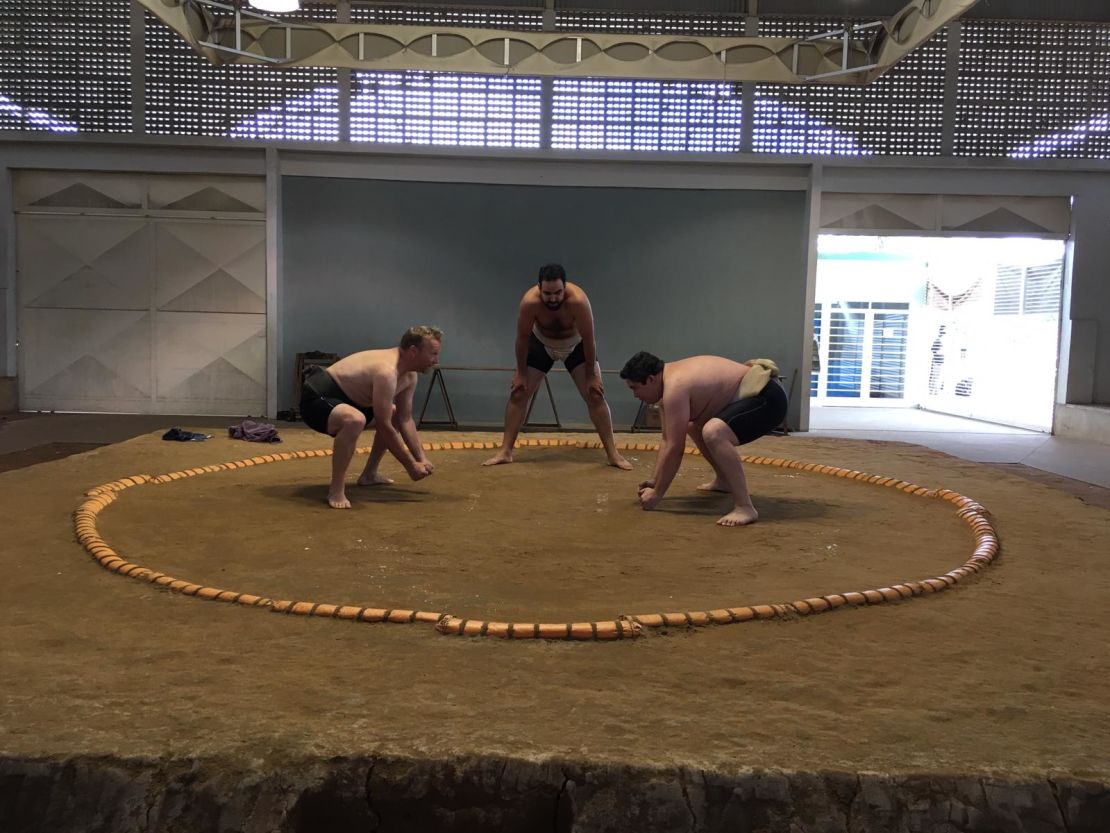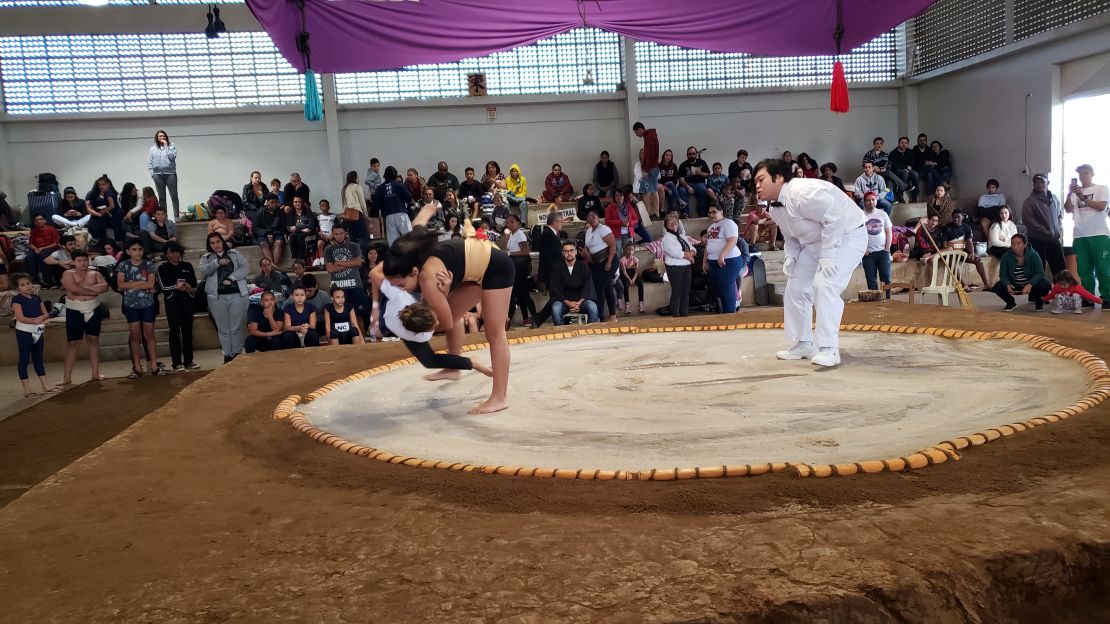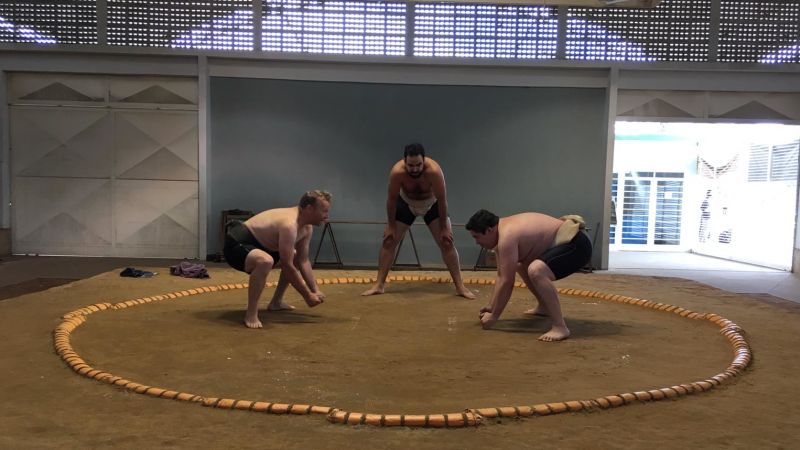Editor’s Note: This CNN Travel series is, or was, sponsored by the country it highlights. CNN retains full editorial control over subject matter, reporting and frequency of the articles and videos within the sponsorship, in compliance with our policy.
A man with strawberry-blonde hair squats to face his dark-bearded, well-toned opponent. Both are wearing black loincloths, and stand in a meticulously groomed circle, surrounded by ceramic tiles that link together to form a perimeter.
They’re about to engage in a sumo wrestling match. But this isn’t a tourist attraction in Japan. This is a serious face-off in Brazil’s only dedicated sumo gymnasium, located in the city of São Paulo.
At the Mie Nishi complex, which opened in 1958 and also houses a baseball stadium, Brazilians come to train, wrestle and watch sumo. The wrestling arena was purpose-built and opened its doors in 1992.
In 2000, the Brazilian Sumo Confederation (CBS) was formed in São Paulo state, and the Brazilian National Championships, alongside the South American Championships, were held in the gymnasium.
With the aid of funding from the São Paulo Federation of Sumo, alongside a public fundraising campaign, the arena was refurbished in 2008, much to the delight of Brazil’s Japanese population.
“At the time, the new gymnasium was considered to be the first and only exclusive sumo gym in the world outside Japan,” says president of the gym Oscar Morio Tsuchiya. It’s still the only one with a traditional clay ring, he says.
Every year since, the Brazilian Sumo Confederation has held major championships there, offering free admission to the public.
A championship was held at the opening in 2008 with around 400 athletes, including wrestlers from Japan.
The championships are now an annual event and, Tsuchiya says, the number of participants has been steadily increasing. He cites the local Japanese community as being “integral” to supporting the training of wrestlers and organizing the competition.
Brazil is home to the largest Japanese population outside Japan – known as “Nikkei” – with the last estimate in 2016 putting the number at 1.9 million.
In the Liberdade neighborhood of São Paulo, where more than half a million Japanese live, Shinto shrines line the streets, their traditional red torii gates framing the avenues in the district known as Little Tokyo.
“Before there was no permanent space for the practice of sumo here in São Paulo,” Tsuchiya continues. “The championships were held in a makeshift manner in various places. Because of this, there were no children in São Paulo who could start practicing sumo, so [it was] only practiced by adults who trained in judo arenas.”
Now, he says, the Brazilian community pull its weight by sending young wrestlers – and women – to the school to train.

There are around 30 members at the gym, many of whom travel for hours from small towns to come and train.
“The success of Brazilian sumo is certainly a source of pride for all those who, like us, work hard to maintain this sport,” Tsuchiya beams.
Brazil now regularly sends wrestlers to national sumo championships, and one of the best sumo wrestlers outside Japan is Brazilian-born Ricardo Sugano, who goes by the name of Kaisei Ichirō.
The third generation Brazilian-Japanese rikishi, or sumo wrestler, turned his back on his homeland’s favorite pastime of soccer to study martial arts, which eventually led him to sumo.
Indeed, Sugano’s training at the gym is a point of pride for Tsuchiya. When asked what some of his favorite memories have been so far, he lists “our dear Ricardo” and his debut at the gym as one of them.
Another wrestler, 25-year-old Rui Junior, drives eight hours to train at Mie Nishi. He’s a 10-time Brazilian champion and a three-time South American champion, and recently competed in the World Sumo Championships in Osaka.
The Japanese government is so pleased with the spread of its sport to Latin America it even sent a coach to the gym to help train budding talent.

However, there is one notable difference at the São Paulo arena: there are women wrestling.
In Japan, women have long been banned from entering, or even touching, the wrestling ring – called dohyō in Japanese. It is traditionally seen as a violation of the purity of the dohyō, a view which critics say is based on the Shinto belief that women are “impure” because they menstruate.
But Tsuchiya says it was important to him to include females in the dohyō ring.
“In order for Sumo to be recognized as an Olympic sport, it is also necessary to have the female sport, so the Brazilian Confederation created the female sport and started the first championship that included females in 2001.”
And Tshuchiya has big dreams for the future, hoping that, some day, his humble gym in Brazil will host the World Championship.
In the meantime, the gym hosts tournaments once a month that are open to the public.
Ginásio de Sumo do Bom Retiro, Av. Pres. Castelo Branco, 5446 – Bom Retiro, São Paulo – SP, 01142-200, Brazil
Read the full article here


